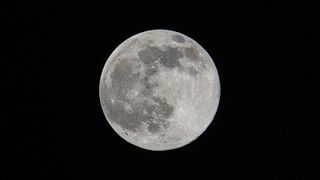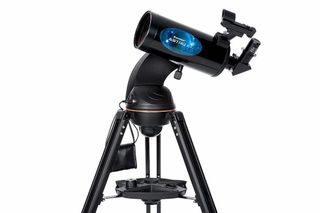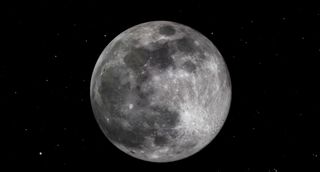Howl at January's Wolf Moon as the 1st full moon of 2023 rises tonight
The moon will also be at its furthest from the Earth during the first full moon of 2023, making it a so-called "micromoon."

The first full moon of the new year, January's Wolf Moon, rises on Friday (Jan. 6). At the same time, the moon will be on the far side of Earth and close to its furthest from the Earth, making it a "micromoon," the opposite of a supermoon.
The full moon will rise around dusk and will set around dawn, meaning the Wolf Moon will be visible for most of the night. According to In the Sky, observers in New York City will see the Wolf Moon rise at 3:21 p.m. EST (2021 GMT) and see it set at 7:26 am EST (1226 GMT).
At the time of the Wolf Moon, the moon will be in the Gemini constellation with a right ascension of 07h12m00s and declination 27°00'N.
Related: Full moon calendar 2023: When to see the next full moon
During the Full Wolf Moon when the moon is close to its furthest from Earth, an astronomical arrangement called apogee, it will be around 91.6 million miles (147.4 million km) from the sun.
At the same time, In the Sky gives Earth's distance from the sun as around 91.4 million miles (147.1 million km) from our star. The distance between the Earth and the moon will be around 250,000 miles (around 400,000 km).

Want to get a closer look at the moon? We recommend the Celestron Astro Fi 102 as the top pick in our best beginner's telescope guide. Don't forget a moon filter if you'll be looking up at the full Wolf Moon!
This makes the Wolf Moon of 2023 a micromoon, in effect the opposite of a "supermoon", which occur during full moons when the moon is closer to the Earth. This situation arises because the moon's orbit around Earth is a flattened circle, or "elliptical." This means there are times when it is closer to Earth and further times when it is further away.
Get the Space.com Newsletter
Breaking space news, the latest updates on rocket launches, skywatching events and more!
Though this does make a difference to how large and bright the moon appears, this difference is so small that it is virtually imperceptible to the naked eye; supermoons are only around 14% larger than moons not at perigee.
Old Farmer's Almanac states that the name for January's full moon, the Wolf Moon arises due to the fact it was seen at times of the year when wolves could be howling outside villages as a result of hunger.
Read more: Full moon names for 2023 (and how they came to be)

Alternative names for the January full moon are the "Old Moon," the suitably wintery monikers the "Frost Moon" and the "Snow Moon" all of which arise from Native American traditions. The name "Snow Moon" is now more commonly associated with February's full moon which next occurs on Feb. 5, 2023.
Whether you're new to skywatching or are a seasoned veteran, be sure to see our guides for the best binoculars and the best telescopes to view the Full Wolf Moon or anything else in the sky. For capturing the best skywatching images you can, we have recommendations for the best cameras for astrophotography and best lenses for astrophotography. We even have a guide on how to photgraph the moon!
Editor's Note: If you get a great photo of the Wolf Moon and would like to share it with Space.com's readers, send your photo(s), comments, and your name and location to spacephotos@space.com.
Follow us on Twitter @Spacedotcom or on Facebook.
Join our Space Forums to keep talking space on the latest missions, night sky and more! And if you have a news tip, correction or comment, let us know at: community@space.com.

Robert Lea is a science journalist in the U.K. whose articles have been published in Physics World, New Scientist, Astronomy Magazine, All About Space, Newsweek and ZME Science. He also writes about science communication for Elsevier and the European Journal of Physics. Rob holds a bachelor of science degree in physics and astronomy from the U.K.’s Open University. Follow him on Twitter @sciencef1rst.